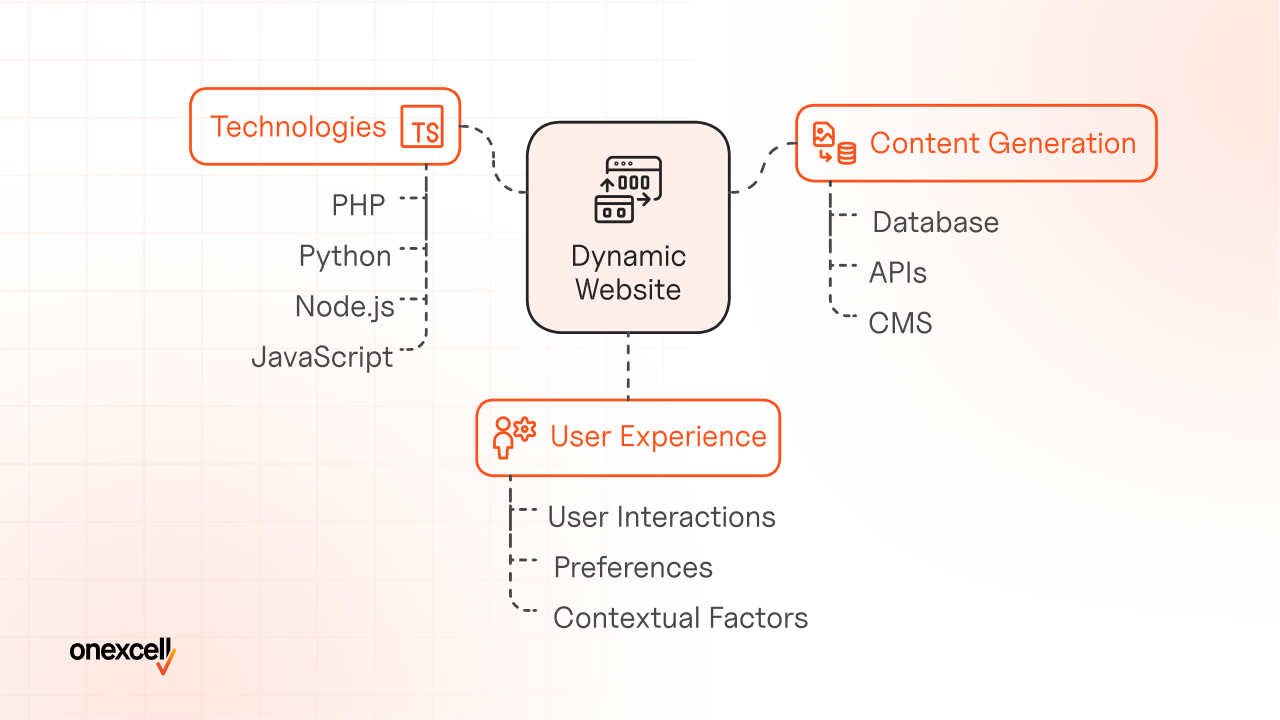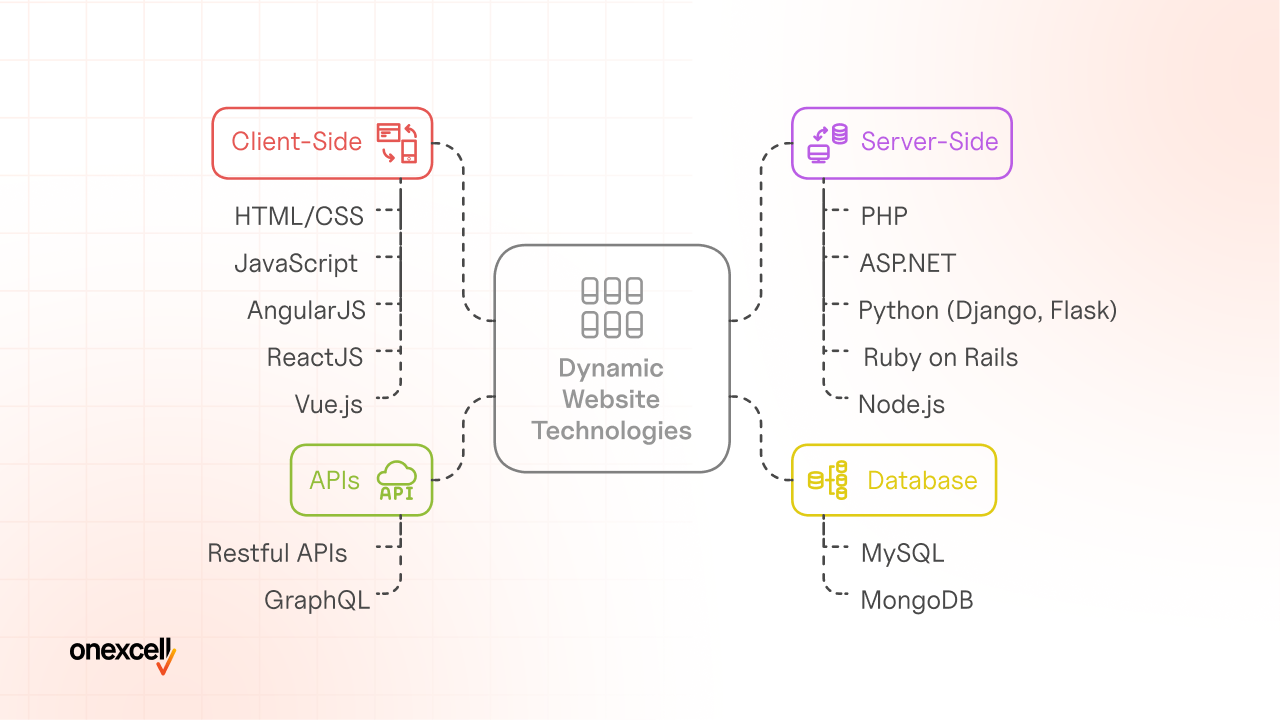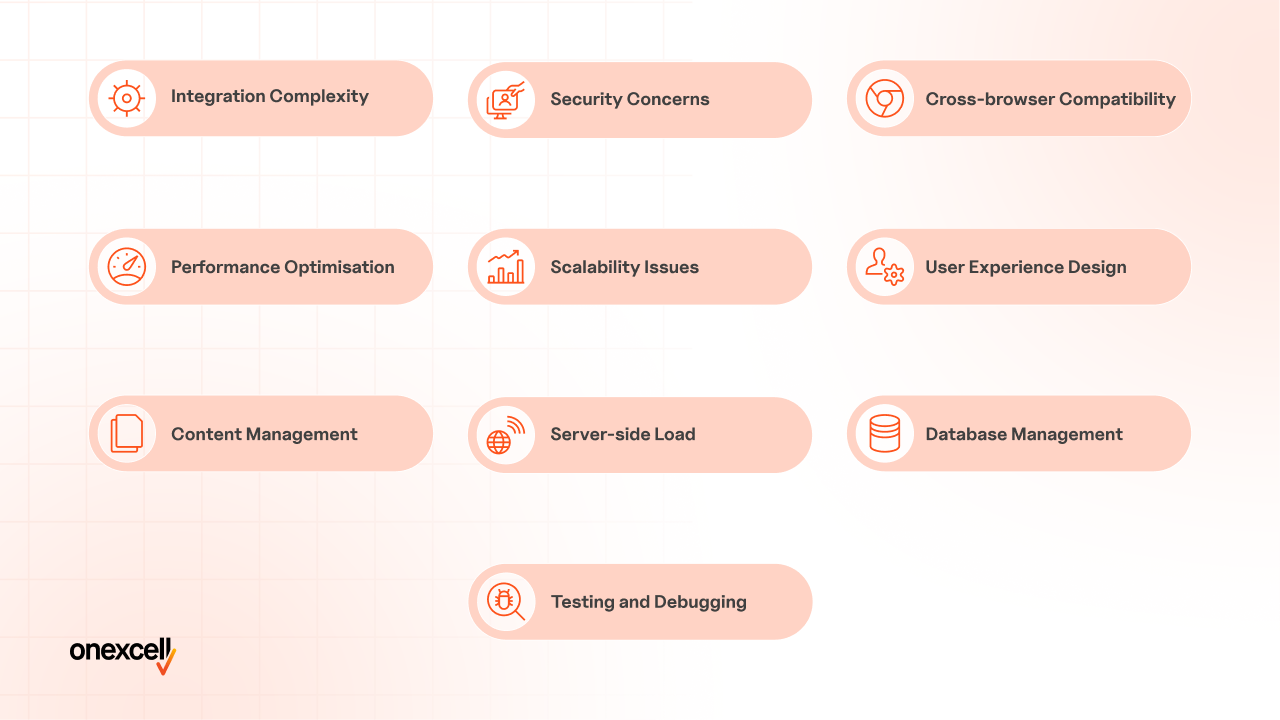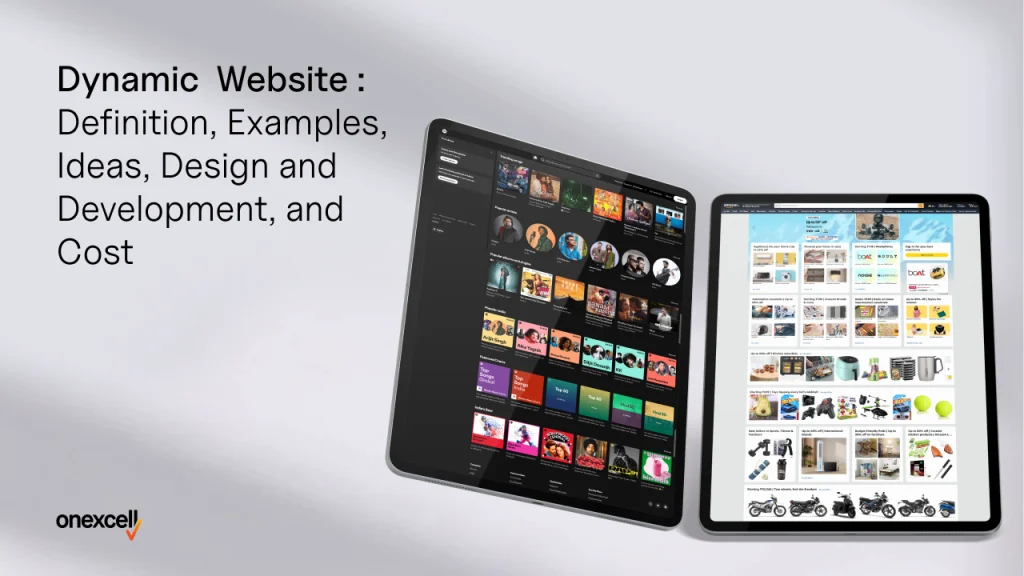Dynamic website is an online platform that includes features like user input processing, database interactions, and real-time updates. It involves server-side scripting languages like PHP or Python. This suggests that dynamic websites use server resources to generate content on the fly, unlike static sites which are served directly by the web server.
According to Neil Patel’s article titled E-commerce Optimisation: 6 Steps to Boost Your Conversion Rates, published on 23 January 2020, e-commerce platforms utilise dynamic elements, such as personalised recommendations, with a conversion rate improvement of 20 to 30%.
The examples of dynamic websites include Amazon, Facebook, YouTube, Wikipedia, Google Maps, Netflix, Spotify, LinkedIn, Twitter, and Airbnb. Amazon is a global e-commerce platform that uses dynamic content to personalise shopping experiences, display real-time inventory, and recommend products based on user behaviour. Facebook is a social networking site that delivers personalised feeds, updates, and targeted advertisements through dynamic data retrieval.
Dynamic websites are designed and developed through a structured process that includes planning, wireframing, front-end and back-end development, database integration, and testing. They use hybrid approaches combining static and dynamic elements to optimise performance. Technologies like MySQL or MongoDB handle database operations, while frameworks like ReactJS or AngularJS enable interactive user interfaces.
The cost of developing a dynamic website varies based on complexity and functionality. Small business websites cost £600 and £3,500, e-commerce platforms range from £2,500 to £15,000, due to features like inventory management and payment gateways, while enterprise-level sites exceed £40,000. Hosting fees and annual maintenance further add to expenses. Comparatively, static websites are simpler and cost £500 to £4,000 but lack the interactivity and scalability required for modern applications.
What is a Dynamic Website?

A dynamic website is a type of website that generates and delivers content in real-time by extracting data from a database or external sources such as APIs, content management systems (CMS), or user inputs. It enables personalised user experiences through user interactions, preferences, or contextual factors such as location, browsing history, or device type.
A dynamic website differs from a static website, which delivers the same pre-written HTML files to all users. In contrast, dynamic websites use server-side processing such as PHP, Python, Node.js or client-side scripting like JavaScript to present content dynamically for each visitor.
According to recent statistics, there are over 1.1 billion websites globally as of 2024, with dynamic websites due to the adoption of CMS platforms like WordPress. WordPress alone powers more than 43% of all websites, underscoring its dominance in supporting dynamic, database-driven content creation.
How do dynamic websites differ from static websites?
Dynamic websites differ from static websites in content generation, user interaction, and server requirements such as database dependencies and server-side processing power.
A static website delivers pre-built HTML pages with minimal interactivity and no server-side processing, making it fast, secure, and easy to host using basic technologies like HTML, CSS, and JavaScript.
In contrast, a dynamic website generates content in real-time based on user inputs or database queries. It relies on server-side technologies such as PHP, Node.js, or Python, and databases like MySQL or MongoDB, making it more complex but well-suited for content-rich or user-driven platforms such as e-commerce stores, social networks, and web applications like online banking or learning management systems.
According to a W3Techs study conducted in 2024, static websites dominate simple blogs and marketing pages, with platforms like Jekyll and Hugo popular among small businesses. In contrast, dynamic websites power 78% of the top 10,000 sites, including platforms like Shopify and Facebook, reflecting their use in complex, interactive applications.
What are the Main Features of Dynamic Websites?
Main features of dynamic websites are designed to deliver personalised, interactive, and responsive experiences by leveraging server-side and client-side technologies. These features enable real-time updates, user-specific content, and interactivity, making dynamic websites ideal for modern applications like e-commerce, social media, and SaaS platforms.
The main features of dynamic websites are listed below.
- Interactive user interface
- Real-time data updates
- Database connectivity
- User authentication
- Customisable content
- API integrations
- Multimedia content
- Dynamic content rendering
- Form handling
- Personalisation features
- Server-side processing
- Enhanced security measures
- Responsive design
Interactive user interface
Dynamic websites feature visuals, animations, and interactive elements such as forms and buttons to boost user engagement. For example, hover effects and animated transitions guide users through the website smoothly, creating a captivating experience. According to LinkedIn’s 2023 report, interactive UI elements enhance user retention rates by up to 25%.
Real-time data updates
Dynamic websites display live data such as news feeds, stock prices, or inventory levels by processing information instantly. This functionality allows users to receive the latest updates without needing to refresh the page. Twitter’s real-time updates on trending topics and tweets exemplify this feature.
Database connectivity
Dynamic websites integrate with databases to store and retrieve user data for personalised content delivery. For instance, e-commerce platforms like Amazon utilise databases to track purchase history and recommend products to individual preferences.
User authentication
Secure login systems on dynamic websites manage user roles and access permissions. This feature is essential for platforms requiring personalised dashboards or protection of sensitive data, such as online banking or educational portals.
Customisable content
Dynamic websites adapt content based on user preferences, browsing history, or real-time behaviour. For example, Netflix customises its homepage recommendations based on viewing history, which accounts for 80% of watched content.
API Integrations
Dynamic websites connect with external services via APIs to fetch live data or extend functionality. Examples include weather updates integrated into travel platforms or payment gateways used in e-commerce sites.
Multimedia content
Dynamic websites support high-quality images, videos, and animations to provide a rich and engaging user experience. Platforms like YouTube utilise multimedia content dynamically to boost viewer engagement.
Dynamic content rendering
Web pages are generated on the fly using server-side scripting languages such as PHP or Python. This allows dynamic websites to deliver customised outputs efficiently based on user requests.
Form Handling
Dynamic websites process user inputs through interactive forms used for surveys, feedback, sign-ups, or transactions. Real-time validation improves user experience and reduces errors during submission.
Personalisation features
Content delivery is according to factors such as location, device type, or previous interactions. Spotify’s “Discover Weekly” playlist is an example of personalised content driven by dynamic algorithms.
Server-Side Processing
Complex operations such as database queries and script execution are handled on the server side to deliver customised outputs efficiently. This makes scalability and reliability for high-traffic platforms like Amazon.
Enhanced security measures
Dynamic websites safeguard sensitive data using encryption protocols, secure login systems, and access controls. These features are essential for e-commerce platforms handling payment details.
Responsive design
Dynamic websites adjust layouts and visuals across different screen sizes and devices. Responsive design is vital for mobile accessibility and increased user engagement.
What are the Types of Dynamic Websites?

Common types of dynamic websites include platforms designed for interactivity, personalised content, and real-time updates. These websites have applications such as e-commerce, social networking, and educational platforms, using server-side processing and database integration for functionality.
The types of dynamic websites are listed below.
- E-commerce websites
- Social networking sites
- Content management systems (CMS)
- Web applications
- Blogs and news sites
- Interactive portals
- Online forums and communities
- Educational platforms
- Booking and reservation systems
- Financial and trading platforms
E-commerce websites
E-commerce websites are types of dynamic website that personalises product listings, manages inventory in real time, and adjusts pricing based on user behaviour and demand. Its platforms like Amazon and Shopify are well-known examples.
Social networking sites
Social networking sites are a type of dynamic website that updates feeds, notifications, and suggestions in real time based on user activity. Facebook and Twitter are leading examples in this category.
Content management systems (CMS)
CMS are a type of dynamic website that allows users to manage and update content across multiple pages without needing to write code. WordPress is one of the most widely used CMS platforms.
Web applications
Web applications are a type of dynamic website that generates content, tools, and dashboards based on user input, roles, or business data. SaaS platforms like HubSpot and Google Workspace are examples of web apps.
Blogs and news sites
Blog or news sites are a type of dynamic website that provides real-time updates and personalised articles based on user location and browsing history. News and blog website examples include BBC and The New York Times.
Interactive portals
Interactive portals are a type of dynamic website that offers interactive features, animations, and real-time updates to improve user experience. Event sites like Dockyard Social use this model effectively.
Online forums and communities
Online forums or communities are the type of dynamic website that manages user-generated content, organises discussions, and recommends threads. Reddit and Stack Overflow are examples of this type.
Educational platforms
Educational platforms are a type of dynamic website that offers personalised course suggestions, adaptive quizzes, and progress tracking. Coursera and Udemy are popular examples.
Booking and reservation systems
Booking and reservation systems are the type of dynamic website that updates availability, pricing, and recommendations in real time based on user searches. Airbnb and Booking.com are key platforms in this category.
Financial and trading platforms
Financial or trading platforms are the type of dynamic website that delivers live data, stock prices, and gives analytics to users. Bloomberg and E*TRADE are its examples.
What are Some Examples of Dynamic Websites?

Common examples of dynamic websites are Amazon, Facebook, YouTube, Wikipedia, Google Maps, Netflix, Spotify, LinkedIn, Twitter, and Airbnb. These websites are designed for interactivity, personalized content delivery, and real-time updates.
The examples of dynamic websites are listed below.
- Amazon
- YouTube
- Wikipedia
- Google Maps
- Netflix
- Spotify
- Airbnb
Amazon
Amazon is an example of a dynamic website that personalises product recommendations based on purchase and search history. It dynamically updates delivery suggestions according to users’ locations and provides real-time inventory updates. Its personalised recommendations drive 35% of Amazon’s total revenue.
Facebook is a dynamic website that updates news feeds, notifications, and friend suggestions in real time based on user activity and preferences. Its algorithms show content according to individual interests. Facebook’s dynamic functionality results in an average user session duration of 33 minutes daily.
YouTube
YouTube is an example of a dynamic website that recommends videos based on users’ watch history, subscriptions, location, and preferences. It also provides real-time updates on trending videos. Over 70% of YouTube watch time is attributed to its recommendation engine and its success in retaining users.
Wikipedia
Wikipedia is a dynamic website that allows real-time editing by contributors worldwide. It dynamically generates pages based on user searches and instant content updates across languages. Wikipedia handles over 18 billion wiki page views monthly.
Google Maps
Google Maps is an example of a dynamic website that dynamically updates navigation routes, traffic conditions, and nearby points of interest based on user location and preferences. Google Maps processes over 25 million daily updates for accurate and real-time navigation worldwide.
Netflix
Netflix is a dynamic website that provides personalised content recommendations based on viewing history. Its homepage dynamically evolves with hover animations and continuous scrolling. Netflix’s recommendation system drives 80% of watched content by users.
Spotify
Spotify is a dynamic website that creates personalised playlists like “Discover Weekly” based on listening habits. It dynamically adjusts song recommendations in real time according to user feedback example., likes or skips. Spotify’s personalisation increases user retention rates by up to 60%, boosting long-term engagement.
LinkedIn is a dynamic website that provides job recommendations, networking suggestions, and feed updates according to user profiles and interactions within their network. LinkedIn’s dynamic features contribute to its high engagement, with over 900 million users globally.
Twitter is a dynamic website that delivers real-time updates on tweets, trending topics, and hashtags based on user interests and location. Its interactivity fosters instant communication. Twitter’s real-time interactivity leads to high daily active user engagement rates.
Airbnb
Airbnb is a dynamic website that displays available accommodations based on search filters like location, dates, and price range while offering personalised travel suggestions. Airbnb processes millions of searches daily with a smooth user interface that enhances the booking experience.
How do e-commerce websites utilise dynamic features?
E-commerce websites like Amazon utilise dynamic features such as personalised recommendations, real-time inventory tracking, and dynamic pricing to enhance user experience and drive sales. Amazon’s recommendation engine employs collaborative filtering and billions of data points, including browsing history and purchase behaviour, to give better product suggestions for individual users.
According to a report by James Cooper (2018), this feature accounts for approximately 35% of Amazon’s total revenue, highlighting the power of personalisation in boosting conversion rates and customer engagement.
How do you Design and Develop a Dynamic Website?
You design and develop a dynamic website by following a structured process that integrates planning, design, development, and testing to create an interactive and scalable platform. A professional web development company handles this process, making sure the website meets performance standards, user expectations, and business objectives effectively.
Below are the steps involved in designing and developing a dynamic website.
- Planning and research
- Defining goals and objectives
- Wireframing and prototyping
- Designing user interface (UI)
- Writing and integrating content
- Front-end development
- Back-end development
- Database design and integration
- Implementing interactive features
- Testing and quality assurance
- Launch and deployment
- Ongoing maintenance and updates
1. Planning and research
Planning and research are fundamental steps in creating a dynamic website. This phase involves identifying the target audience, analysing competitors, and researching industry trends to understand user needs and preferences. Defining the website’s purpose, whether for e-commerce, social networking, or educational content, is critical.
According to McKinsey, companies that conduct thorough market research are more likely to achieve higher returns on investment (ROI), highlighting the importance of research in aligning the website with user expectations and business goals.
2. Defining goals and objectives
Defining clear goals and objectives is essential for guiding the development process. This involves setting specific, measurable, achievable, relevant, and time-bound (SMART) goals. For instance, if the goal is to increase user engagement, the website focuses on dynamic features like personalised content recommendations or real-time updates.
A study by HubSpot found that websites with well-defined objectives are more likely to achieve higher user satisfaction and conversion rates.
3. Wireframing and prototyping
Wireframing involves creating a basic visual representation of the website’s layout and structure. Prototyping goes further by creating interactive models that simulate the user experience. Tools such as Figma or Adobe XD are commonly used.
Research by Nielsen Norman Group found that interactive prototypes reduce development time by up to 50% by identifying and fixing design flaws before coding begins, proving the efficiency of prototyping in the development process.
4. Designing user interface (UI)
Designing a user-friendly and responsive UI is crucial for dynamic websites. The UI should be intuitive, visually appealing, and adaptable across different devices and screen sizes. A responsive design provides users with a better experience, whether on a desktop, tablet, or mobile device.
Google’s research indicates that 53% of users abandon websites that take longer than three seconds to load, emphasising the importance of efficient design for retaining users.
5. Writing and integrating content
Developing high-quality content is essential for engaging users and driving conversions. Dynamic websites integrate content based on user preferences, location, or real-time behaviour. E-commerce platforms use algorithms to recommend products based on purchase history.
Content should also be optimised for search engines to improve visibility and accessibility. Research has shown that SEO-optimised content increases website traffic by up to 50%.
6. Front-end development
Front-end development involves coding the website’s client-side using HTML, CSS, and JavaScript. This step focuses on creating visually appealing and interactive pages that respond to user actions. It includes modern front-end frameworks like React or Angular.
According to a Stack Overflow survey, developers using modern front-end frameworks report higher productivity and better maintainability of their codebase.
7. Back-end development
Back-end development involves creating the server-side logic, database integration, and API connectivity using languages like PHP, Python, or Node.js. This step is essential for managing user data, processing requests, and generating dynamic content in real time.
Back-end development makes sure that the website handles complex operations efficiently and scales with growing traffic, which is key for high-traffic platforms.
8. Database design and integration
Database design involves structuring data storage for efficient retrieval and updates. Dynamic websites rely on databases to store user data, preferences, and other relevant information. Tools like MySQL or MongoDB are commonly used.
IBM found that well-designed databases improve data retrieval speeds by up to 90%, greatly enhancing website performance and user satisfaction.
9. Implementing interactive features
Implementing interactive features such as search functionality, user authentication, or real-time updates enhances user engagement. Technologies like AJAX or WebSocket enable dynamic updates without requiring full page reloads. These features are essential for creating a responsive and immersive user experience, making them fundamental to dynamic website functionality.
10. Testing and quality assurance
Testing evaluates the website for usability, performance, security, and compatibility across different browsers and devices. Quality assurance processes help identify and fix bugs before launch, reducing post-launch maintenance costs.
A study by Forrester showed that thorough testing could reduce website downtime by up to 40%, improving reliability and user satisfaction.
11. Launch and deployment
Deploying the website on a reliable hosting platform with scalability options is crucial for handling increased traffic. Cloud hosting services such as AWS or Google Cloud make websites responsive under high traffic loads. Scalable deployment is a key factor for high availability and user retention.
12. Ongoing maintenance and updates
Regular maintenance involves updating content, monitoring performance metrics, and implementing new features based on user feedback. This ongoing process makes the website relevant, secure, and optimised for user engagement.
According to Cloudinary (2025), dynamic websites are ideal for businesses aiming for scalability and personalisation, as they handle increased traffic while delivering content in real time.
What technologies are used to create dynamic websites?

Technologies used to create dynamic websites are HTML/CSS, JavaScript, PHP, ASP.NET, Python (Django, Flask), Ruby on Rails, Node.js, AngularJS, ReactJS, Vue.js, MySQL, MongoDB, RESTful APIs, and GraphQL for real-time updates through a combination of client-side and server-side scripting, database integration, and APIs.
Below are the technologies that are used to create dynamic websites.
- HTML/CSS: HTML and CSS form the foundation of dynamic websites, defining the structure and styling of web pages.
- JavaScript: JavaScript enables client-side interactivity such as animations, form validation, and DOM manipulation.
- PHP: PHP is a server-side scripting language that generates dynamic content by processing user requests and accessing databases.
- ASP.NET: ASP.NET is a Microsoft server-side framework used for building scalable, secure dynamic web applications.
- Python (Django, Flask): Python frameworks like Django and Flask simplify server-side scripting, database handling, and API integration.
- Ruby on Rails: Ruby on Rails is a web framework ideal for building dynamic sites with features like authentication and data management.
- Node.js: Node.js allows server-side scripting with JavaScript, enabling real-time applications such as messaging systems.
- AngularJS: AngularJS is a JavaScript framework for creating dynamic single-page applications with real-time data binding.
- ReactJS: ReactJS is a JavaScript library for building interactive user interfaces with reusable components.
- Vue.js: Vue.js is a progressive JavaScript framework for creating reactive and component-based dynamic web applications.
- MySQL: MySQL is a relational database system used in dynamic websites to manage and retrieve structured data efficiently.
- MongoDB: MongoDB is a NoSQL database ideal for storing unstructured data in scalable, high-traffic dynamic websites.
- RESTful APIs: RESTful APIs enable dynamic websites to communicate with external services and backend systems.
- GraphQL: GraphQL is a query language that allows efficient, specific data fetching for dynamic websites.
How do you Integrate Databases into Dynamic Websites?
Databases integrate into dynamic websites by enabling the efficient storage, retrieval, and management of your data, allowing for personalised, real-time content delivery. These databases use SQL, such as MySQL, for structured data, or NoSQL, like MongoDB, for unstructured data, depending on your website’s needs.
Dynamic websites that use server-side languages like PHP, Python, or Node.js to interact with these databases, supporting functionalities such as user authentication, personalised recommendations, and e-commerce transactions.
Development costs are influenced by various factors, including the complexity of your website design, hosting infrastructure, and database scalability. Advanced features or large datasets increase the demand for powerful back-end systems and secure data handling. Hosting costs vary based on whether cloud, VPS, or dedicated servers are used, while maintaining a scalable and secure database setup adds to ongoing expenses.
According to PowerImporter (2024), dynamic websites with efficient database integration leads to an increase in conversion rates by up to 300%.
What is the Cost of Developing a Dynamic Website?
The cost of developing a dynamic website in 2025 varies based on factors such as website type, features, complexity, and maintenance requirements. Simple websites with basic functionality, such as small business sites, costs range from £600 and £35,00, including CMS integration and responsive design.
E-commerce sites, requiring advanced functionalities like payment gateways, inventory management, and custom user experiences, range from £2,500 to £15,000. For large-scale enterprise websites with complex features like SaaS platforms or global marketing portals, development costs exceed £15,000 and £40,000.
Key factors that influence the development costs include the complexity of design, functionality requirements such as third-party integrations or dynamic content, database setup like SQL or NoSQL, and hosting fees.
Ongoing maintenance costs range from £300 to £5,000 annually, depending on the website’s scale and the need for continuous updates.
According to Forbes, businesses that invest in professional websites see a return on investment (ROI) ranging from 200% to 400%, driven by improved visibility, lead generation, and customer engagement.
In North America, developers charge between £80 and £160 per hour, while European developers charge between £40 and £120 per hour. In contrast, Asian developers offer more competitive rates, ranging from £16 to £40 per hour. These differences in developer pricing, combined with ongoing maintenance and hosting costs, all contribute to the total expense of developing and maintaining a dynamic website.
How does the cost of developing dynamic websites compare to static websites?
The cost of developing dynamic websites ranges from £600 to over £40,000, depending on the scale and features, making them more expensive than static websites due to their complexity and resource demands.
Dynamic websites require server-side programming, database integration, and CMS functionality, whereas static websites are simpler to build and maintain, with costs ranging from £500 to £4,000. Hosting fees for dynamic websites are also higher, as they need more server power to handle real-time data processing and interactivity.
According to Wix (2025), dynamic websites are ideal for businesses needing scalability and personalisation, while static websites are more suited to projects with limited interactivity and infrequent updates.
What factors contribute to the higher cost of dynamic websites?
Factors contributing to the higher cost of dynamic websites include the complexity of the design, advanced functionality, the need for custom development, and many others.
Below are the factors that contribute to the increased costs.
- Complexity of design
- Advanced functionality
- Custom development
- Integration with third-party systems
- Content management features
- Performance optimisation
- Security measures
- Responsive and adaptive design
- Database management
- Ongoing maintenance and support
- Testing and quality assurance
What are the applications of dynamic websites?
Dynamic websites are applied in industries such as e-commerce, banking, healthcare, and education where interactivity, real-time data, and user personalisation are essential.
Below are the applications of dynamic websites.
- E-commerce platforms
- Social media sites
- Online marketplaces
- News and media websites
- Educational portals
- Healthcare services
- Banking and financial services
- Travel and booking systems
- Customer relationship management (CRM) systems
- Entertainment and streaming services
How does a hybrid approach work in dynamic website development?
A hybrid approach works by combining static and dynamic elements to optimise speed and user experience in dynamic website development. Static components, such as headers or footers, are pre-rendered for fast loading times, while dynamic sections like personalised recommendations or live data updates are generated in real-time using server-side or client-side rendering.
This balance of hybrid approach reduces server strain while maintaining interactivity and scalability. E-commerce websites use hybrid models to deliver static category pages quickly while dynamically updating inventory and pricing.
According to CloudCannon (2024), hybrid websites improve performance by up to 40%, making them ideal for high-traffic applications requiring both efficiency and personalisation.
Do dynamic websites support e-commerce platforms?
Yes, dynamic websites support e-commerce platforms by enabling advanced functionalities such as inventory management, personalised product recommendations, and secure payment processing. They integrate databases to store and retrieve user data, allowing features like customer accounts, shopping carts, and real-time updates on stock availability.
According to Hostinger (2024), dynamic e-commerce platforms improve user experience and conversion rates by offering recommendations based on browsing history and past purchases of users.
What are the benefits of dynamic websites for SEO?
The benefits of dynamic websites for SEO are listed below.
- Improved user experience
- Higher engagement rates
- Fresh and updated content
- Better indexing by search engines
- Enhanced mobile optimisation
- Personalised user experience
- Higher conversion rates
- Better analytics and tracking
- Increased backlink opportunities
- Improved social sharing
What are the main challenges in building dynamic websites?

The main challenges in building dynamic websites are listed below.
- Complexity of integration
- Security concerns
- Cross-browser compatibility
- Performance optimisation
- Scalability issues
- User experience design
- Content management
- Server-side load
- Database management
- Testing and debugging
Do dynamic websites improve user interaction?
Yes, dynamic websites improve user interaction by offering features such as interactive forms, live chats, personalised content, and real-time updates. Web design services are incorporating these elements to engage with the site and creating a richer user experience. Personalised recommendations based on browsing behaviour for relevance, while dynamic visuals and animations keep visitors engaged and invested in the content.
According to WebFX (2024), interactive design reduces bounce rates by encouraging users to spend longer on a site, with video-based content increasing engagement by 88% and improving brand association by 139%.

